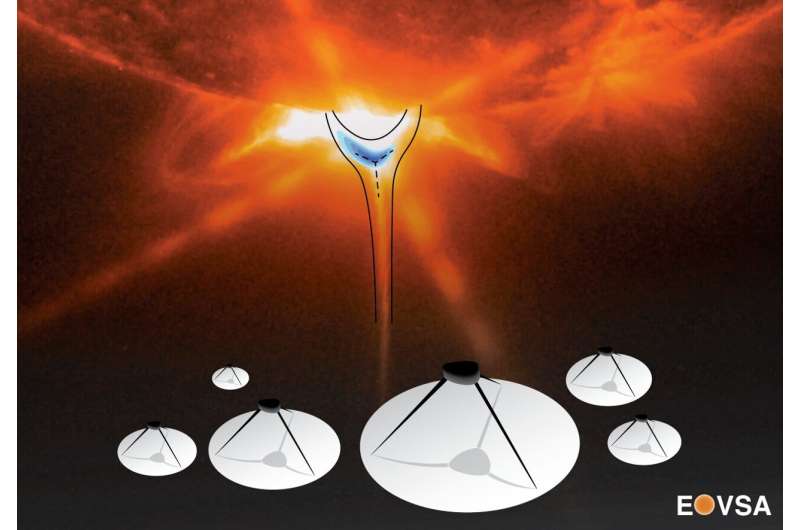
Solar flares are among the most violent explosions in our solar system, but despite their enormous energy,physicists still haven't been able to answer exactly how these sudden eruptions on the sun are able to launch particles to Earth.
The exact location where solar flare charged particles are accelerated to near-light speed has been identified by researchers at the New Jersey Institute of Technology.
The new findings, made possible through observations of an X-class solar flare in 2017, have revealed a highly efficient particle accelerators located at the tip of the bright point of the eruption in the sun's outer
The discovery of the region, measuring almost twice the volume of Earth, could open new doors for investigating fundamental processes in the universe.
Gregory Fleishman is a distinguished research professor of physics at NJIT's Center for Solar-Terrestrial Research and the paper'sCorresponding Author. The flare unleashed its power in a much larger region of the sun than was expected. This is the first time the size, shape, and location of this key region has been identified, and the efficiency of the energy conversion to particle acceleration inside the flare has been measured.
The NJIT team's lead on the location was initially given by the detailed snapshots of the flare and changes in the sun's magnetic field taken by EOVSA.
Bin Chen, NJIT associate professor and co-author of the paper, said that they weren't certain where the high-energy electrons were produced. We found a magnetic bottle-like structure at the site that contained an overwhelmingly large number of electrons compared to anywhere else in the flare, but now with the new measurement of this study, we can more confidently say this is the flare's particle accelerator.
The team was able to measure the energy spectrum of electrons at hundreds of locations of an X-class solar flare triggered by a reconfiguration of magnetic field lines.
The map of the flare's thermal plasma was given byEOVSA. Gelu Nita, NJIT research professor and co-author of the paper, said that they found a mysterious hole in the thermal plasma map. The hole was filled with high-energy particles after thermal particles disappeared.
The team's analysis showed how the energy from the sun's magnetic fields can be converted into energy inside the particle accelerator.
The co-author of the study asked how efficient the energy conversion process would be. The particles had all been accelerated to non-thermal energies greater than 20 keV, which is consistent with the EOVSA measurement, and we were able to confirm that.
The new findings could help scientists study fundamental questions in particle physics not possible on Earth, as well as offer new insights into how high-energy particles from the sun may impact Earth during future space weather events.
Dale Gary, NJIT distinguished professor and director of EOVSA, says that the study directs the attention of theorists to the precise location where most of the energy release and particle acceleration happens. The Frequency Agile Solar Radiotelescope, which will be at least 10 times larger and orders of magnitude more powerful, is being developed to be used to measure flare regions and flare events.
Particle acceleration in solar flares can be investigated. The main energy release at the region and the 100% efficiency at which charged particle acceleration occurs must be accounted for in future studies. The models used to study solar flares need to be revised.
More information: Gregory Fleishman, Solar flare accelerates nearly all electrons in a large coronal volume, Nature (2022). DOI: 10.1038/s41586-022-04728-8The decay of the magnetic field can allow enough energy to be released to power a solar flare. There is a science.aax6874
The measurement of magnetic field and relativistic electrons along a solar flare current sheet was done by Bin Chen and colleagues.